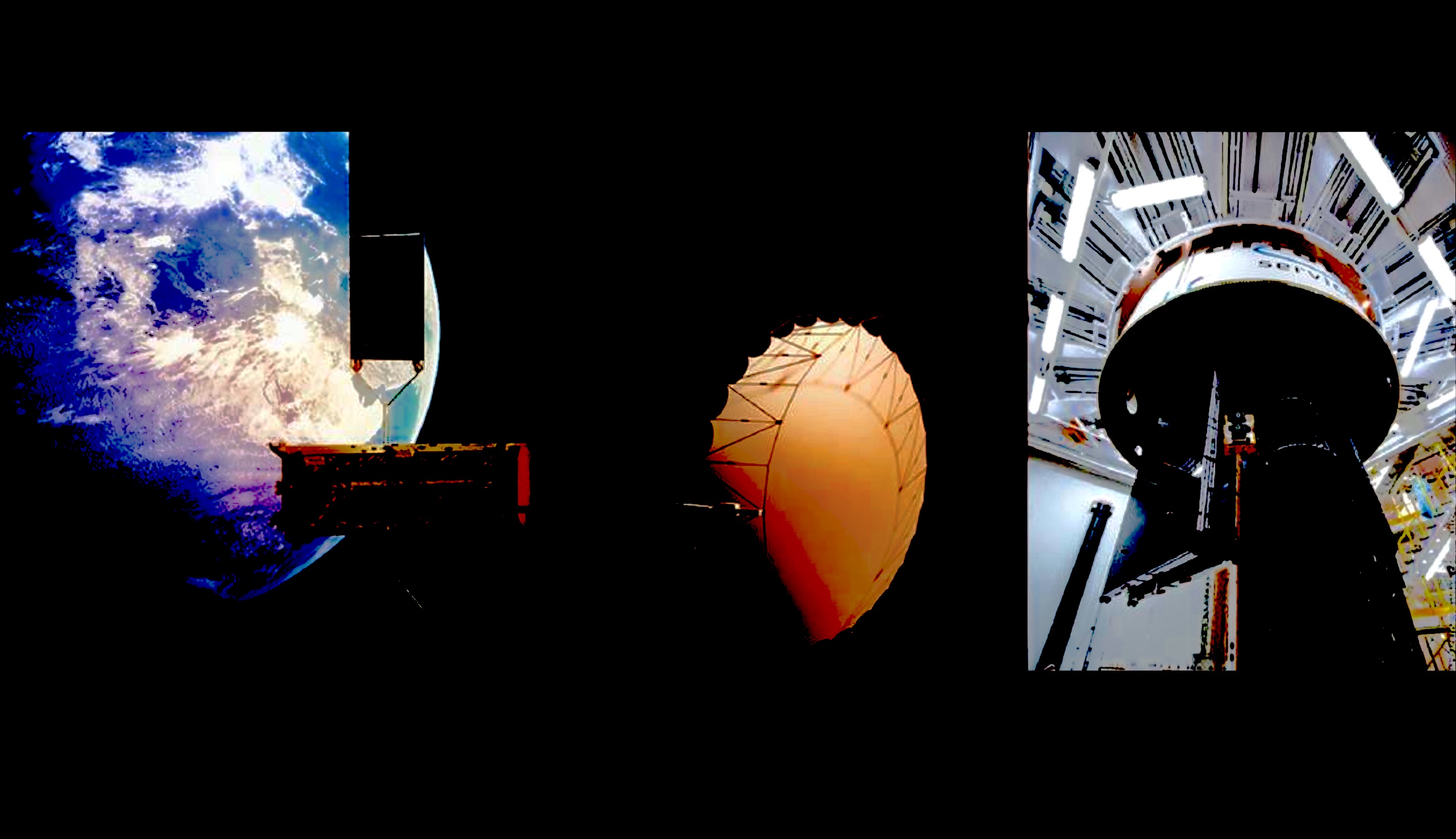Efforts in the realm of electric propulsion have been both steady and cutting-edge. Past, present, and future projects are discussed along with both realized and potential mission benefits arising from this recent technology.
Electric Propulsion (EP) is a class of space propulsion, which makes use of electrical power to accelerate a propellant by different possible electrical and/or magnetic means. The use of electrical power enhances the propulsive performances of the EP thrusters compared with conventional chemical thrusters. Unlike chemical systems, electric propulsion requires very little mass to accelerate a spacecraft. The propellant is ejected up to twenty times faster than from a classical chemical thruster and therefore the overall system is many times more mass efficient. Reduced propellant mass consumption can lead to lower mission costs and/or can allow embarking more experiments on satellites. Electric Propulsion is not limited in energy, but is only limited by the available electrical power on-board the spacecraft. Therefore EP is suitable for low-thrust (micro and milli-newton levels), long duration (high Isp) applications on board satellites.
Typically, an Electric Propulsion system is composed of one or more electrical thrusters connected to their Power Processing Units (PPUs) and to a propellant storage and feeding system (including tanks, pressure regulators, flow control units, valves, etc.) and to pointing mechanisms. Figure 1 shows EP system architecture.
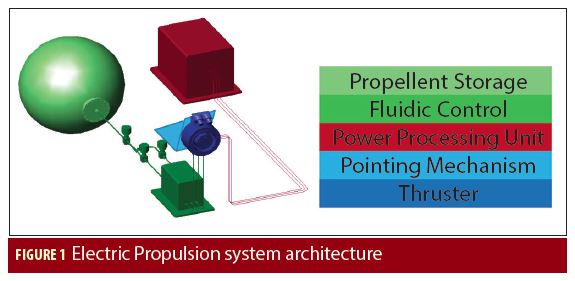
The development and production of an Electric Propulsion system involves a significant number of industrial organizations. Whilst thrusters and PPUs are specific to a technology, pressure regulators and pointing mechanisms need not be technology specific and are usually chosen based on individual mission requirements.
Electric thrusters are generally described in terms of method used to accelerate charged particles and produce the thrust. Following this logic, EP systems are classified according to three categories: electro-static, electro-magnetic, and electro-thermal thrusters:
• Electro-static: Gridded Ion Engines, Field Emission Electric Propulsion, Colloidal Thrusters
• Electro-magnetic/electro-static thrusters: Hall Effect Thrusters, HEMPTs
• Electro-magnetic thrusters: Magneto Plasma Dynamic thrusters, Pulse Plasma Thrusters
• Electro-thermal: Arcjets, Resistojets
Depending on the specific field of application, thrusters falling into one of these three categories can be more or less attractive, depending on their particular thrust capabilities, electrical power consumptions, and other propulsion performance characteristics (Isp).
The propellant used in EP systems varies with the type of thruster and can be a rare gas (i.e., xenon, krypton or argon), a liquid metal (i.e., cesium or indium), or an ionic liquid.
The level of development and flight heritage of the different thruster types can vary significantly. In Europe, developments have been carried out in all the different areas of electric propulsion over the last four decades (see Figure 2 for suppliers). Gridded Ion Engines (GIEs) and Hall Effect Thrusters (HETs) have emerged as leading electric propulsion technologies in terms of performance. These thrusters operate in the power range of hundreds of watts up to tens of kilowatts with an Isp of thousands of seconds to tens of thousands of seconds, and they produce thrust levels typically of some fraction of a newton. Figure 3 compares their performance.
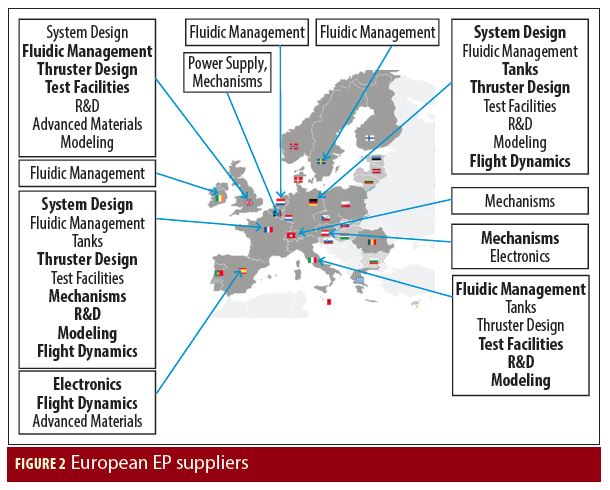
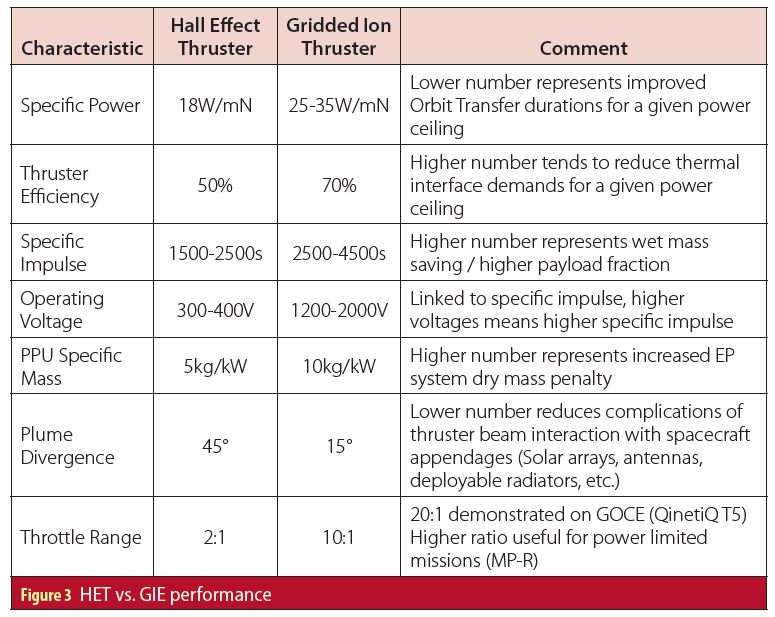
In Hall Effect Thrusters (see Figure 4), electrons from an external cathode enter a ring-shaped accelerating channel attracted by an anode. Xenon gas is released into the channel. Permanent magnet or coils embedded within the thruster structure generate a magnetic field with a magnitude selected so that only electrons are excited and the influence on ions is neglected. Electron excitement causes propellant ionization and ion acceleration when gas crosses the EXB field. The accelerated ions leaving the channel generate thrust. The electrons from the cathode are also used to avoid spacecraft charge.
In Gridded Ion Engines (see Figures 5 and 6), Xenon gas is ionized by electron bombardment or through radiofrequency electron excitement. The ions are then extracted and accelerated using a high electrostatic potential applied to a grid system. An external neutralizer emits the electrons necessary to neutralize the space charge of the emerging ion beam.
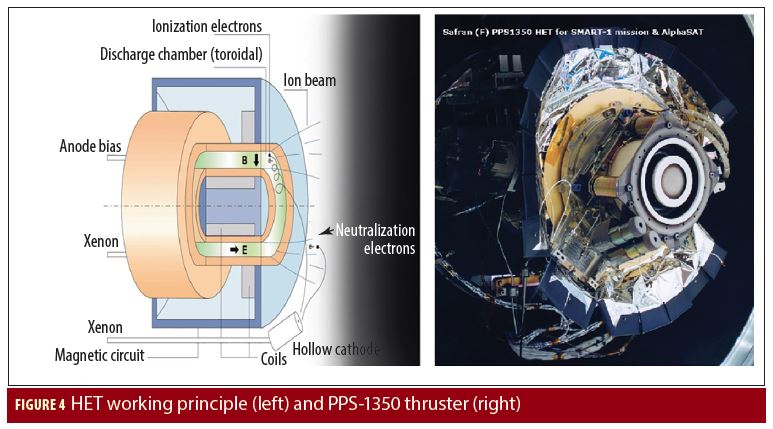
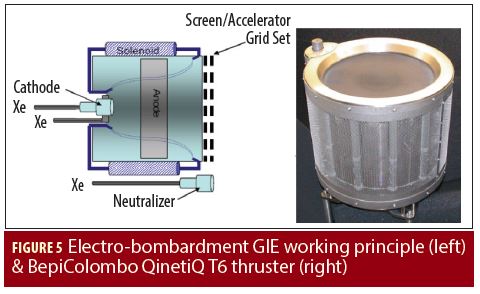
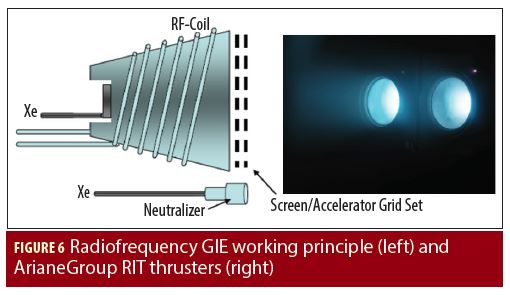
Electric Propulsion Applications
Embarking propulsion capabilities on-board a satellite can serve multiple purposes:
• Station keeping: satellites shall compensate for perturbations to maintain the desired orbital position:
◉ LEO orbits are perturbed by the aerodynamic drag
◉ Gravitational fields of the Moon and the Sun affect the inclination of GEO satellites in North-South
◉ Non-circular shape of Earth’s equator causes perturbations in East-West
• Attitude management: satellites shall generate a momentum to off-load the reaction wheels used for attitude control.
• Orbital maneuvering: orbit transfer/raising from launch orbit to the operational orbit, relocation and disposal at end-of-life.
Since the 1970s, Electric Propulsion has been used for station-keeping, orbit-raising, and as primary propulsion on telecommunications and science missions. Increasingly, it is being considered for Earth observation, navigation, and orbit debris removal.
More recently, constellations of CubeSats, or small satellites with the mass ranging from one kilogram to few hundreds of kilograms, are also planning to use Electric Propulsion to enhance their capabilities.
Telecommunication
Commercial GEO telecommunication represents the largest market for electric propulsion. In the last 20 years, these satellites have become more competitive with the adoption of EP for North-South Station Keeping (NSSK) and Electric Orbit Raising (EOR). Launchers deliver these satellites into Geostationary Transfer Orbits (GTO) and orbit-raising maneuvers to reach GEO are then performed by the onboard propulsion. With Chemical Propulsion, orbit-raising takes up to one week but about half of satellite wet mass is propellant. With Electric Propulsion, orbit-raising takes up to six months but launch mass can be reduced by 40%. Telecommunication satellites using EP have greater appeal since the propellant mass saved can be used to accommodate larger and more complex payloads. In addition, in the last decade, the trend in GEO Telecommunication satellites has consolidated into a considerable increase in electrical power to satisfy the payload needs. The availability of such high power allows for the operation of the EP subsystem without requiring additional power or changes in the platform design. On the other hand, the low thrust produced by the EP thrusters means extended firing times and longer transfers to reach the final operational orbit. This implies reduced revenue in the short-term, but important savings in the long run.
Electric propulsion was primary used on Russian commercial satellites. In 1997 Boeing made the world’s first American EP telecoms satellite, PanAmSat, using XIPS gridded ion engines for station-keeping and chemical thrusters for orbit-raising maneuvers.
In 2001, the European Space Agency’s (ESA’s) ARTEMIS (the Advanced Relay and Technology Mission Satellite, Figure 7) offered the first European flight demonstration of European EP thrusters for orbit-raising, recovering the satellite to its final orbit following a launcher anomaly.
In 2005, Space System Loral started to use Russian SPT100 Hall Effect Thrusters for station keeping.
In 2010, Lockheed Martin’s Advanced Extremely High Frequency (AEHF) satellite, after an anomaly with its main Chemical Propulsion system, used Hall Effect Thrusters intended for station keeping to complete its orbit-raising.
In 2013 Thales and Airbus delivered the first large telecoms satellite, AlphaSat, using a set of four SAFRAN AIRCRAFT ENGINES PPS1350 thrusters for station keeping (Figure 8).
In 2015, Boeing successfully demonstrated the world’s first all-electric spacecraft using XIPS Ion Engines for station keeping and orbit-raising.
In 2017, the ESA-OHB SmallGEO platform (Figure 9) was launched equipped with 8 SPT-100 thrusters to fulfil all the orbital manoeuvres for 15 years. In the same year, the EUTELSAT 172B satellite, an “all-electric” built by Airbus DS, reached geostationary orbit in record time by using these 5 kilowatt Hall Effect Thrusters.
European satellite manufacturers have been using electric propulsion for station keeping for more than 10 years: on Eurostar 3000 produced by Airbus, on Spacebus 4000 produced by Thales Alenia Space, on SmallGEO produced by OHB). All European Primes are now developing their new all-electric platforms, NEOSAT and ELECTRA, which use EP for both orbit raising and station keeping. By 2020, it is estimated that more than half of all commercial satellites sold will be all-electric or hybrid (embarking both chemical and electric systems).
The European Space Agency, the National Space Agencies and industries have invested in the development of electric thrusters for the GEO market at SAFRAN AIRCRAFT ENGINES (Hall Effect Thrusters), SITAEL (Hall Effect Thrusters), QINETIQ (Ion Engines), ARIANEGROUP (Ion Engines), and THALES (HEMPT). These products are now competing with those from U.S. and Russia.
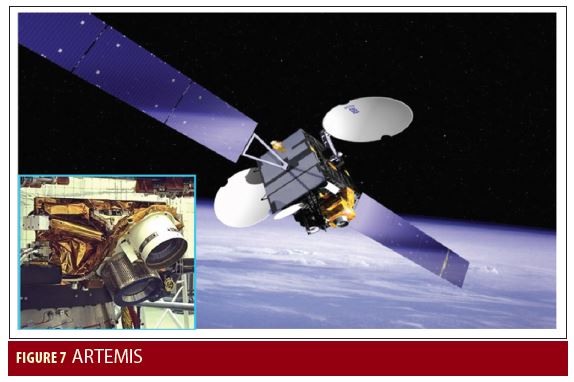
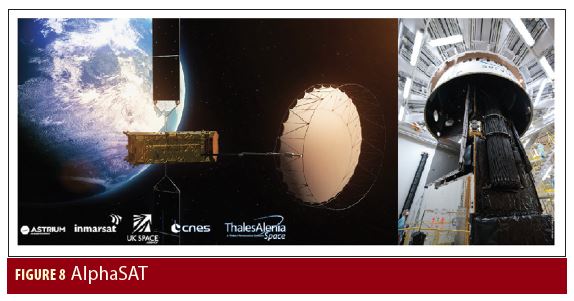

Navigation
The Galileo Second Generation (G2G) program is considering the use of EP for constellation deployment and satellites disposal at end of life. Electric Propulsion is thought to enhance payload capability and flexibility in deployment strategy. The full exploitation of launch vehicle capabilities and the design of efficient transfer trajectories are major components of developing an efficient deployment strategy for Galileo. Multiple satellite configurations are currently been studied to find solutions that satisfy accommodation requirements of the payload, solar arrays, and propellant, demonstrate sufficient mechanical and thermal performance, support the desired level of modularity, and ensure the ability to fit multiple spacecraft on European launchers. As the selection of EP thruster has a large impact on the satellite design, detailed trade-offs are still being carried out to analyze combinations of thruster type, number, and operating point in order to optimize satellite design with an acceptable transfer duration, to ensure failure robustness and technical maturity.
Science & Exploration
The use of electric propulsion for scientific spacecraft is recognized as an important way to enhance mission performance. Replacing or augmenting chemical propulsion with electric thrusters as the primary propulsion system can bring the following benefits:
• an increase in net payload mass
• a reduction in flight time with respect to mission based on chemical propulsion and complex gravity-assisted operations
• independence from launch-window constraints, which are imposed by the classical gravity-assisted planetary fly-by operations
• possibility of using small/medium launch vehicles (providing substantial launch-cost savings)
Specific mission requirements, in terms of power availability, satellite mass, and mission profile, dictate the choice of the particular EP technology to be used.
Deep Space 1 was the first use of EP on an interplanetary mission, and its main objectives, the fly-by of asteroid Braille and Comet Borrelly, were successfully performed by NASA’s NSTAR ion engine in the late 1990s. The JAXA science mission Hyabusa used Japanese ion engines to rendezvous with an asteroid in 2005.
ESA’s first Moon mission, SMART-1 (Figure 10), paved the road for the use of EP on European Science and Exploration missions. The mission was technically and scientifically a success, helping ensure Europe’s technology competence in this promising technology as well as in lunar exploration. The relatively small satellite, equipped with one PPS-1350G HET from SAFRAN AIRCRAFT ENGINES, required only 82 kilograms of Xenon to reach and orbit the Moon.
ESA’s cornerstone missions, BepiColombo, will provide the best understanding of Mercury to date by studying and understanding the composition, geophysics, atmosphere, magnetosphere, and history of Mercury, the least explored planet in the inner Solar System. BepiColombo, launched in October 2018, is propelled by four 5kW T6 Gridded Ion Engines developed by QinetiQ (Figure 11).
Future scientific missions such as LISA (Laser Interferometer Space Antennas) (Figure 12) may require electric microthrusters as very fine control actuators to ensure operation under drag-free conditions. These thrusters should also have a long lifetime. FEEP, colloidal thrusters, and miniaturized ion engines are main candidates for these kinds of missions.
ESA is currently studying the future evolution of the Exploration program and is assessing the possibility of implementing a technology mission that allows testing future technologies required for exploration missions. High-power EP (15-20 kilowatts) is considered a perfect candidate to perform an interplanetary cruise. Initiatives such as CISLUNAR will require 12.5-20 kilowatt Hall Effect Thrusters to keep the station around the Moon and/or transfer it to Mars. The first European prototype of a 20 kilowatt HET was built and tested in the frame of the HiPER project (High Power Electric propulsion: a Roadmap for the future) co-funded by the European Union under the space theme of the 7th Framework Program. Starting in 2015, ESA is also funding the development of a 20 kilowatt HET at SITAEL S.p.A..
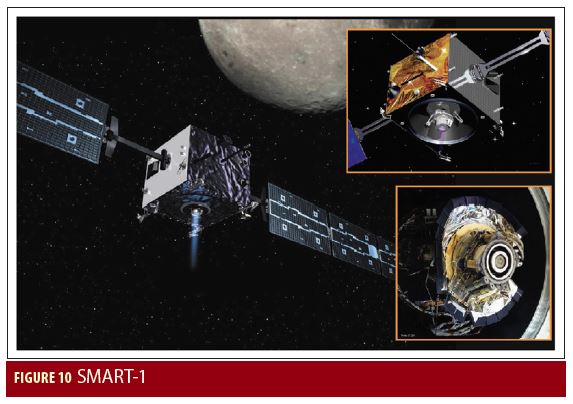
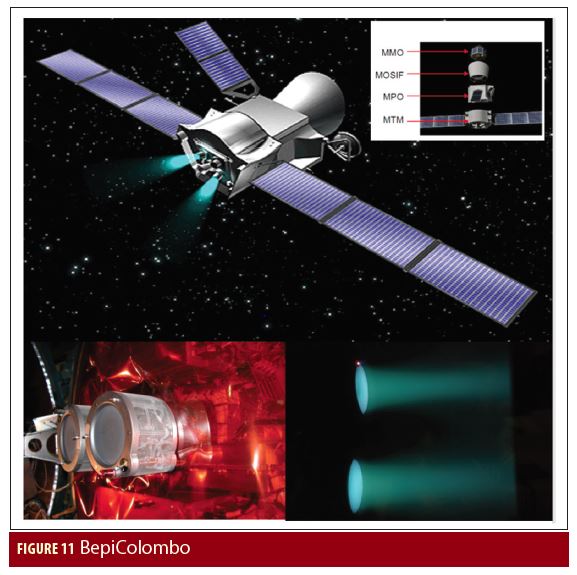
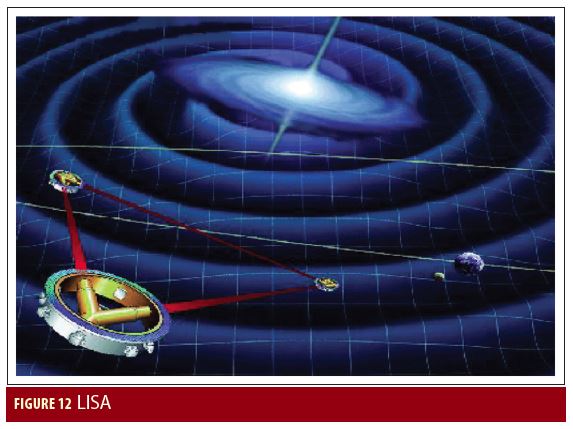
Earth Observation
Earth observation missions, like GOCE (Figure 13), also benefitted from the use of EP. The main aim of the GOCE mission was to provide unique models of Earth’s gravity field and its geoid to high spatial resolution and accuracy. The T5 GIE system from QinetiQ was operated on GOCE almost continuously from 2009 to 2013 to compensate aerodynamic drag. The engine performance exceeded the expectations and enabled a mission that met not only the baseline requirements, but was so successful that its duration was doubled from two years to four years.
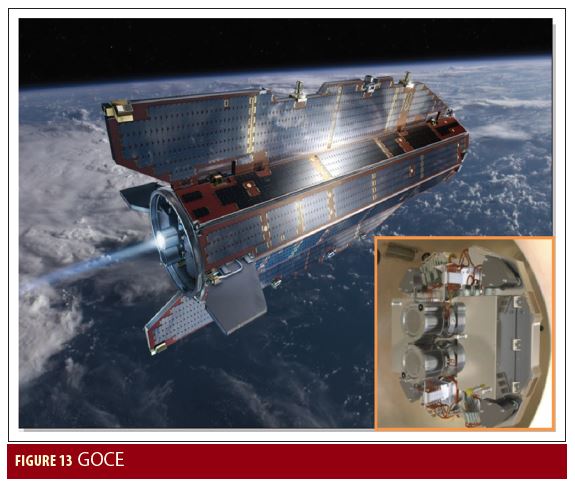
The success of the ion engine in the GOCE spacecraft has demonstrated the potential of this technology for fine control of satellites flying in LEO.
Next Generation Gravity Missions (NGGM) is considering miniaturized GIE from ARIANEGROUP and FEEP from FOTEC to compensate drag.
Furthermore, the use of small ion engines, small HETs, FEEPs, or helicon antenna thrusters would enable operation of Earth observation satellites at much lower altitude orbits. Studies and development programs have been conducted considering the use of atmospheric gases as propellant for electric thrusters (RAM-EP) to enable continuous operation at altitudes lower than 200 kilometers.
Finally, constellations of thousands of satellites are currently being developed. These satellites are launched in clusters and need low power EP to reach their operational orbit, stay there, and be disposed at the end of the mission. Low-cost and versatile electric propulsion systems will be required as the cost of the system must be one order of magnitude lower than current prices.
Space Transportation
Based on growing maturation of electric propulsion systems and increasing capabilities of such propulsion devices, possible applications to space transportation vehicles have gradually been studied with more and more detailed levels of analysis. It is possible today to gather the different classes of applications around the two following families of concepts:
• Electric kick stages for launchers to increase performance capabilities (e.g., Electric-Vega)
• Space Tugs for GEO servicing, LEO/MEO Debris Removal, LEO/MEO to GEO tugging, and Moon cargo delivery
CubeSats
Numerous EP micro-propulsion systems are currently under development in Europe to enhance the performance of CubeSats by enabling drag compensation, orbit keeping, formation flying, orbit transfer, and de-orbiting at end of life. Their compactness, good performance, and low price are increasingly appealing as the space industry interest in small satellites (mass ranging from one to a few hundreds of kilograms) grows all over the world. These satellites, often in constellation, could provide commercial services such as global internet coverage and monitoring of air and sea traffic or Earth observation to broadcast weather and monitor the response to natural disasters.
A miniaturized version of the Indium FEEP thruster for CubeSats and small satellites, the IFM Nano thruster (Figure 14, left image), is under development at Enpulsion and FOTEC (A) to provide highly accurate thrust ranging from 10 to 400 micronewtons at 40 watts with an Isp up to 6,000 seconds.
A Pulsed Plasma Thruster (PPT) for CubeSats, PPTCUP (Figure 14, right image), is being developed by a consortium led by Mars Space (UK) to provide thrust of 40 micronewtons at 2 watts with an Isp of 600 seconds.
A consortium led by Queen Mary University (UK) is developing a very compact and highly efficient Electrospray Colloid EP system.

The “Electric Propulsion Innovation & Competitiveness” (EPIC) The European Commission funded, as part of the Horizon 2020 Space Work Programme 2014, a Programme Support Activity (PSA) for the implementation of the Strategic Research Cluster (SRC) on “In-Space electrical propulsion and station keeping”. The goal of the SRC is to enable major advances in Electric Propulsion for in-space operations and transportation, in order to contribute to guarantee the leadership of European capabilities in electric propulsion at world level within the 2020-2030 timeframe, always in coherence with the existing and planned developments at national, commercial and ESA level. This grant is structured along the two lines of Incremental Technologies and Disruptive Technologies. ESA is the coordinator whereas the team is made by several national space agencies and industries.
Incremental Technologies are the most mature technologies having flight heritage, with the physical principal well understood, and with established performance. They are the Hall Effect Thruster (HET), the Gridded Ion Engines (GIE), and the High Efficiency Multistage Plasma Thrusters (HEMPT). Under EPIC, these Incremental Technologies shall improve their current performance and reduce their cost in order to increase their competitiveness in the global market.
Disruptive Technologies are very promising EP concepts which could disrupt the propulsion sector by providing a radical improvement in performance and/or cost reduction, leading to becoming the preferred technology for certain applications/markets or enabling new markets or applications not possible with the existing (Incremental) technologies.
The selected Incremental Technologies contracts are: CHEOPS on HET, GIESEPP on GIE, and HEMPT-NG on HEMPT technologies.
The selected Disruptive Technologies contracts are: GaNOMIC on PPU innovative Technologies, HiperLoc-EP on the Electrospray Colloid EP System, and MINOTOR on the Electron Cyclotron Resonance Accelerator thrusters.
Conclusions
Since the 1970s, Electric Propulsion has been used on satellites for station-keeping, orbit-raising, and primary propulsion. It has traditionally had applications for telecommunications and science missions, but increasingly the use of EP is being considered for Earth observation, navigation, and space transportation.
More recently, constellations of small satellites (e.g., SpaceWeb) are being designed to use electric thrusters to perform the transfer to the operational orbit and other functions. Thanks to the mass savings made possible by the use of electric propulsion, fewer launchers are needed to place the constellation in orbit, thereby allowing a major cost reduction for the service being offered. The use of EP is also capable of enhancing the services offered by CubeSATs.
Europe is highly capable in the area of Electric Propulsion, stemming from decades of research and development. This expertise is exemplified by the success of ESA missions, such as ARTEMIS, SMART1, GOCE, and AlphaSAT, that have paved the way to the use of electric propulsion on BepiColombo and European commercial telecom platforms such as Neosat and Electra.
Electric propulsion is currently considered by all space actors as a key and revolutionary technology for the new generations of commercial and scientific satellites. Initiatives in this field all over the world are aimed at the development of competitive new generations of Electric Propulsion systems. In Europe too, all stakeholders including the European Space Agency, the National Space Agencies and industrial players have been setting efforts to develop and increase the competitiveness of the European EP technology for the different types of markets.
ESA is strongly involved and committed in this technology area, both as an initiator of electric propulsion system developments and as a user of this technology for its new missions. ESA’s goal is to maintain the competitiveness of European industries by ensuring the availability of qualified, cost-effective, and reliable EP systems, and to make new and challenging space missions possible.
Acknowledgements
This article is based on a paper presented at the Munich Aerospace Summer Summit on Green Aerospace, June 2017.
Additional Resources
(1) Aguirre, M., A. Tobias, and M. Schuyer, “Propulsion System for the Gravity and Ocean Circulation Explorer Mission,” Second European Spacecraft Propulsion Conference (ESA-SP-398), Paper B2/1, May 1997
(2) Goebel, D. M. and I. Katz, “Fundamentals of Electric Propulsion: Ion and Hall Thrusters”
(3) Gonzalez del Amo, J. et alia, Q/A -{[ Should we name all the authors here ?]} “ESA Propulsion Laboratory (EPL),” International Electric Propulsion Conference, September 2011
(4) Gonzalez del Amo, J., Electric Propulsion Technologies, Technical Dossier, Harmonization, ESA, 2017
(5) Gonzalez del Amo, J., “Electric Propulsion Activities at ESA,” International Electric Propulsion Conference, October 2017
(6) Kutufa, N., “Small GEO Platform Propulsion System Overview,” Space Propulsion, May 2008
(7) Saccoccia, G., J. Gonzalez del Amo, and D. Estublier, “Electric Propulsion: A Key Technology for Space Missions in the New Millennium”
Authors
Davina Di Cara is an Electric Propulsion Engineer in the Electric Propulsion Section of the European Space Agency since 2006. She started her career in Space in 2004 at ESA as graduated trainee in the Electric Propulsion Section. She has Master degree (LAUREA) in Aerospace Engineering from Politecnico di Torino, Italy. She has been involved in several research and development activities on Electric Propulsion supervising industrial developments and carrying out testing at the ESA Propulsion Laboratory. She has been involved in many ESA mission studies and projects such as Smart-1, Lisa-Pathfinder, Small-GEO, EGEP, Galileo 2nd Generation, Galileo Transition Satellites, etc.
José Gonzales Del Amo is the Head of the Electric Propulsion Section at ESA since October 2003 and the ESA Propulsion Laboratory Manager since 2004. He was before Electric propulsion Engineer in the Electric Propulsion Section at ESA from 1991 to 2003. He started his career in Space, in 1989, at ESA as graduated trainee in the Power Conversion Division. He has a Master degree in Applied Physics (University Autonoma de Madrid) and in Space Systems Engineering (University of Delft). He has been involved in many research and development activities on Electric Propulsion supervising the industrial developments and carrying out testing and research activities at the ESA Propulsion Laboratory since 1991. He has been involved in many ESA projects such as Artemis, Smart-1, GOCE, Bepi Colombo, Lisa-pathfinder, AlphaBus, Neosat, Small GEO, Electra, Galileo Evolution, etc. He has been also the responsible for the roadmap of the Electric propulsion Technology within the ESA Harmonisation programme and the roadmap preparation for all the propulsion systems called Propulsion 2000. He has 115 papers in the field.
Em. Univ.-Prof. Dr.-Ing. habil. Dr. h.c. Guenter W. Hein is Professor Emeritus of Excellence at the University FAF Munich. He was ESA Head of EGNOS & GNSS Evolution Programme Dept. between 2008 and 2014, in charge of development of the 2nd generation of EGNOS and Galileo. Prof. Hein is still organising the ESA/JRC International Summerschool on GNSS. He is the founder of the annual Munich Satellite Navigation Summit. Prof. Hein has more than 300 scientific and technical papers published, carried out more than 200 research projects and educated more than 70 Ph. D.´s. He received 2002 the prestigious Johannes Kepler Award for “sustained and significant contributions to satellite navigation” of the US Institute of Navigation, the highest worldwide award in navigation given only to one individual each year. G. Hein became 2011 a Fellow of the US ION. The Technical University of Prague honoured his achievements in satellite navigation with a Doctor honoris causa in Jan. 2013. He is a member of the Executive Board of Munich Aerospace since 2016.

